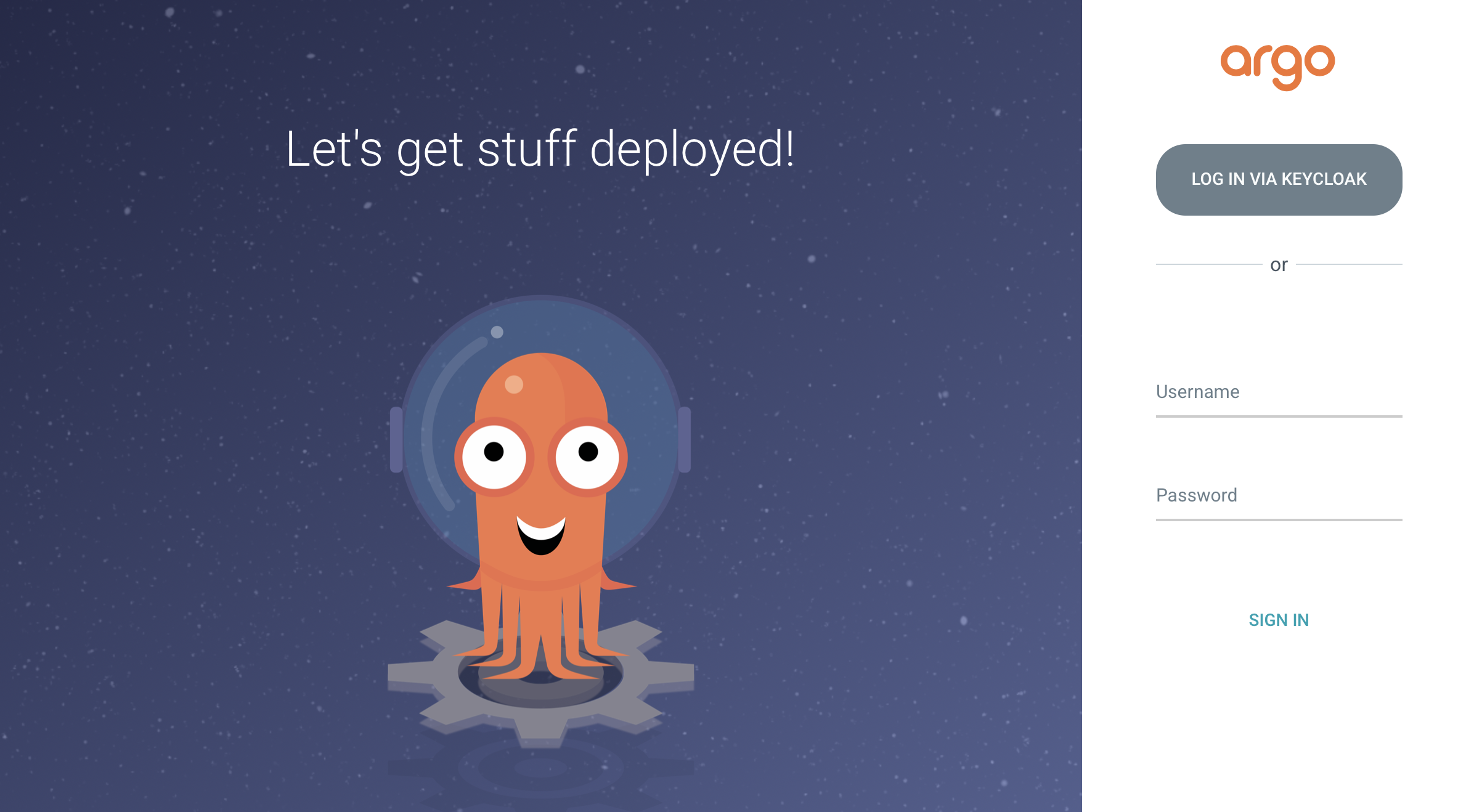Usage¶
This document describes the usage of Keycloak as a Single sign-on provider for ArgoCD.
The following example shows the most minimal valid manifest to create a new Argo CD cluster with keycloak as a Single sign-on provider.
This guide assumes a Kubernetes cluster based on minikube.
Ingress Controller¶
Ensure that the ingress addon is enabled for the minikube cluster.
The addon is disabled by default, enable it if necessary.
minikube addons enable ingress
Verify that the ingress Pod is running. In this example, the ingress controller is running in the ingress-nginx namespace.
kubectl get pods -A
NAMESPACE NAME READY STATUS RESTARTS AGE
ingress-nginx nginx-ingress-controller-6fc5bcc8c9-vg26z 1/1 Running 0 9h
The following example shows the most minimal valid manifest to create a new Argo CD cluster with Keycloak as a Single sign-on provider.
apiVersion: argoproj.io/v1alpha1
kind: ArgoCD
metadata:
name: example-argocd
labels:
example: basic
spec:
sso:
provider: keycloak
server:
ingress:
enabled: true
insecure: true
If your keycloak is setup with a certificate which is not signed by one of the well known certificate authorities you can provide a custom certificate which will be used in verifying the Keycloak's TLS certificate when communicating with it.
Add the rootCA to your Argo CD custom resource .spec.sso.keycloak.rootCA field. The operator reconciles to this change and updates the oidc.config in argocd-cm configmap with the PEM encoded root certificate.
Note
Argo CD server pod should be restarted after updating the .spec.sso.keycloak.rootCA.
Please refer to the below example:
apiVersion: argoproj.io/v1alpha1
kind: ArgoCD
metadata:
name: example-argocd
labels:
example: basic
spec:
sso:
provider: keycloak
keycloak:
rootCA: |
---- BEGIN CERTIFICATE ----
This is a dummy certificate
Please place this section with appropriate rootCA
---- END CERTIFICATE ----
server:
ingress:
enabled: true
Note
.spec.sso.Image, .spec.sso.Version, .spec.sso.Resources and .spec.sso.verifyTLS fields are no longer supported in Argo CD operator v0.8.0 onwards. Please use equivalent fields under .spec.sso.keycloak to configure your keycloak instance.
Note
If you test the operator locally using make run, please add .spec.sso.keycloak.verifyTLS: false to your Argo CD CR. Specifying conflicting information in both specs will result in errors.
Create¶
Create a namespace for Argo CD.
kubectl create ns argocd
Create a new Argo CD Instance in the argocd namespace using the provided example.
kubectl create -n argocd -f examples/argocd-keycloak-k8s.yaml
Note
verifyTLS option should be set to true if you want to enable strict TLS validation in production. If you are running operator on your machine using operator-sdk run local, verifyTLS should be set to false.
Keycloak Instance¶
The above configuration creates a Keycloak instance and its relevant resources along with the Argo CD resources. The default credentials for Keycloak is admin/admin.
Get the Keycloak Ingress URL for Login.
kubectl -n argocd get ingress keycloak
NAME HOST/PORT
keycloak keycloak-ingress
If you running Kubernetes on minikube. Add keycloak hostname to the /etc/hosts file on the local machine, which is needed to access the services running locally on minikube.
Run the below commands using root user.
echo "`minikube ip` keycloak-ingress" | sudo tee -a /etc/hosts
Make sure an entry for keycloak-ingress is added in the /etc/hosts.
Argo CD Login¶
Get the Argo CD Ingress URL for Login.
kubectl -n argocd get ingress example-argocd-server
NAME HOST/PORT
example-argocd-server example-argocd
As explained above, add example-argocd hostname to the /etc/hosts file on the local machine, which is needed to access the services running locally on minikube.
echo "`minikube ip` example-argocd" | sudo tee -a /etc/hosts
Login to Argo CD using the ingress URL. You can see an option to Log in via keycloak apart from the usual ArgoCD login.

Click on LOGIN VIA KEYCLOAK.
You can create keycloak users by logging in to keycloak admin console using the Keycloak admin credentials and Keycloak Ingress URL.
Note
Keycloak instance takes 2-3 minutes to be up and running. You will see the option LOGIN VIA KEYCLOAK only after the keycloak instance is up.
RBAC¶
By default any user logged into ArgoCD will have read-only access. User/Group level access can be managed by updating the argocd-rbac-cm configmap.
The below example show how to grant user foo with email ID foo@example.com admin access to ArgoCD. More information regarding ArgoCD RBAC can be found here
policy.csv: |
g, foo@example.com, role:admin
Uninstall¶
You can delete the Keycloak resources and its relevant configuration by removing the SSO field from ArgoCD Custom Resource Spec.
Example ArgoCD after removing the SSO field should look something like this.
apiVersion: argoproj.io/v1alpha1
kind: ArgoCD
metadata:
name: example-argocd
labels:
example: basic
spec:
server:
ingress:
enabled: true